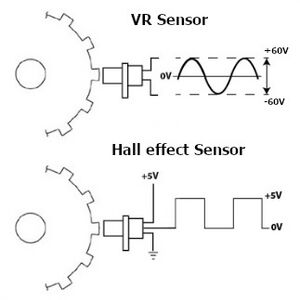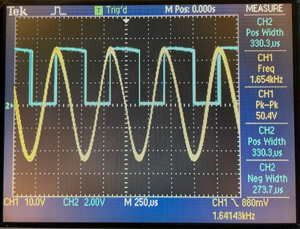MD0 Mod Екн2: Difference between revisions
SnakeTuning (talk | contribs) No edit summary Tag: wikieditor |
SnakeTuning (talk | contribs) No edit summary Tag: wikieditor |
||
| Line 1: | Line 1: | ||
{{DISPLAYTITLE:Tech Details and Explanation}} | {{DISPLAYTITLE:Tech Details and Explanation}} | ||
[[File:VR_Hall_Waveforms.jpg|right|thumb|Fig. 1. [[VR_SENSOR|VR Sensor]] vs [[HALL_SENSOR|Hall sensor]]]] | |||
In the distributors of Honda B, D, F, and H Series engines, there are three [[VR_SENSOR|Variable Reluctance Sensors]]: CKP, TDC, and CYP. The voltage across these sensors varies with the engine's RPM, ranging from approximately ±5V to ±60V. | In the distributors of Honda B, D, F, and H Series engines, there are three [[VR_SENSOR|Variable Reluctance Sensors]]: CKP, TDC, and CYP. The voltage across these sensors varies with the engine's RPM, ranging from approximately ±5V to ±60V. | ||
[[VR_SENSOR|VR Sensors]] is critical for the ECU to maintain correct engine angle tracking. Unlike modern [[HALL_SENSOR|Hall sensors]], which provide a digital output, [[VR_SENSOR|VR Sensors]] produce an analog signal whose amplitude varies with the speed of the engine (see Fig. 1). This variability can lead to signal integrity issues at high RPMs, where precision is critical for efficient engine performance. | [[VR_SENSOR|VR Sensors]] is critical for the ECU to maintain correct engine angle tracking. Unlike modern [[HALL_SENSOR|Hall sensors]], which provide a digital output, [[VR_SENSOR|VR Sensors]] produce an analog signal whose amplitude varies with the speed of the engine (see Fig. 1). This variability can lead to signal integrity issues at high RPMs, where precision is critical for efficient engine performance. | ||
[[File:Coming_soon_right.jpg|right|thumb|Honda ECU [[VR Conditioner]]]] | |||
To process these high-voltage signals and converting them into digital output in the Honda ECU installed a daughter-board, also known as [[VR Conditioner]]. The distinctive feature of this [[VR Conditioner]] is its adaptive sensitivity reduction to the input voltage from the [[VR_SENSOR|VR Sensors]] as the engine RPM increases. | To process these high-voltage signals and converting them into digital output in the Honda ECU installed a daughter-board, also known as [[VR Conditioner]]. The distinctive feature of this [[VR Conditioner]] is its adaptive sensitivity reduction to the input voltage from the [[VR_SENSOR|VR Sensors]] as the engine RPM increases. | ||
Revision as of 15:08, 31 May 2024
In the distributors of Honda B, D, F, and H Series engines, there are three Variable Reluctance Sensors: CKP, TDC, and CYP. The voltage across these sensors varies with the engine's RPM, ranging from approximately ±5V to ±60V.
VR Sensors is critical for the ECU to maintain correct engine angle tracking. Unlike modern Hall sensors, which provide a digital output, VR Sensors produce an analog signal whose amplitude varies with the speed of the engine (see Fig. 1). This variability can lead to signal integrity issues at high RPMs, where precision is critical for efficient engine performance.

To process these high-voltage signals and converting them into digital output in the Honda ECU installed a daughter-board, also known as VR Conditioner. The distinctive feature of this VR Conditioner is its adaptive sensitivity reduction to the input voltage from the VR Sensors as the engine RPM increases.
This is a logical approach for handling VR Sensors as the input voltage can change significantly. However, this poses a significant problem when emulating distributor functions. The accuracy and correctness of ignition calculations are highly sensitive to the input voltage at the ECU. If the voltage is not correct at current RPM, Ignition begins to "drift" and later "missfire".
Waveforms are illustrate two scenarios: normal voltage at 8000 RPM and reduced voltage where signals are missed every other tooth. The blue trace shows the output from the VR Conditioner, and the yellow trace is the input from the VR Sensor. This visualization helps in understanding the need for stable input voltage for accurate ignition timing.
To emulate distributor signals, one might consider designing an electronic device to mimic the function of VR sensors. However, the characteristics of VR sensors and the necessity of double converting the signal—from low voltage to high voltage and back—can severely impact the accuracy of ignition timing at high RPMs. Additionally, high-voltage emulation would not be compatible with Aftermarket ECUs without additional signal converters. After a detailed study of the VR conditioner's operation in Honda's ECU, engineers at SnakeTuning found and patented (Patent pending) a simpler and more effective solution to this problem. They proposed "locking" the adaptiveness of the VR conditioner, which would allow the ECU to consistently work with low-voltage signals. The modification involves leveraging the capabilities of digital circuits and microprocessor-based devices, where input data can be stored in various ways. In contrast, in analog circuits, the only storage element is a capacitor. In this case, the capacitor "remembers" the voltage level corresponding to the engine's rotational frequency, and the ECU's internal scheme changes input sensitivity based on the voltage at this "storage" capacitor. By finding and short-circuit, linking the three "storage" capacitors (one for each sensor), it ensures that their voltage does not rise with increased engine RPMs, thereby maintaining the ECU's sensitivity at its maximum throughout the operational range. This approach effectively addresses the challenges of traditional distributor-based systems and paves the way for more advanced engine tuning and performance enhancements.

